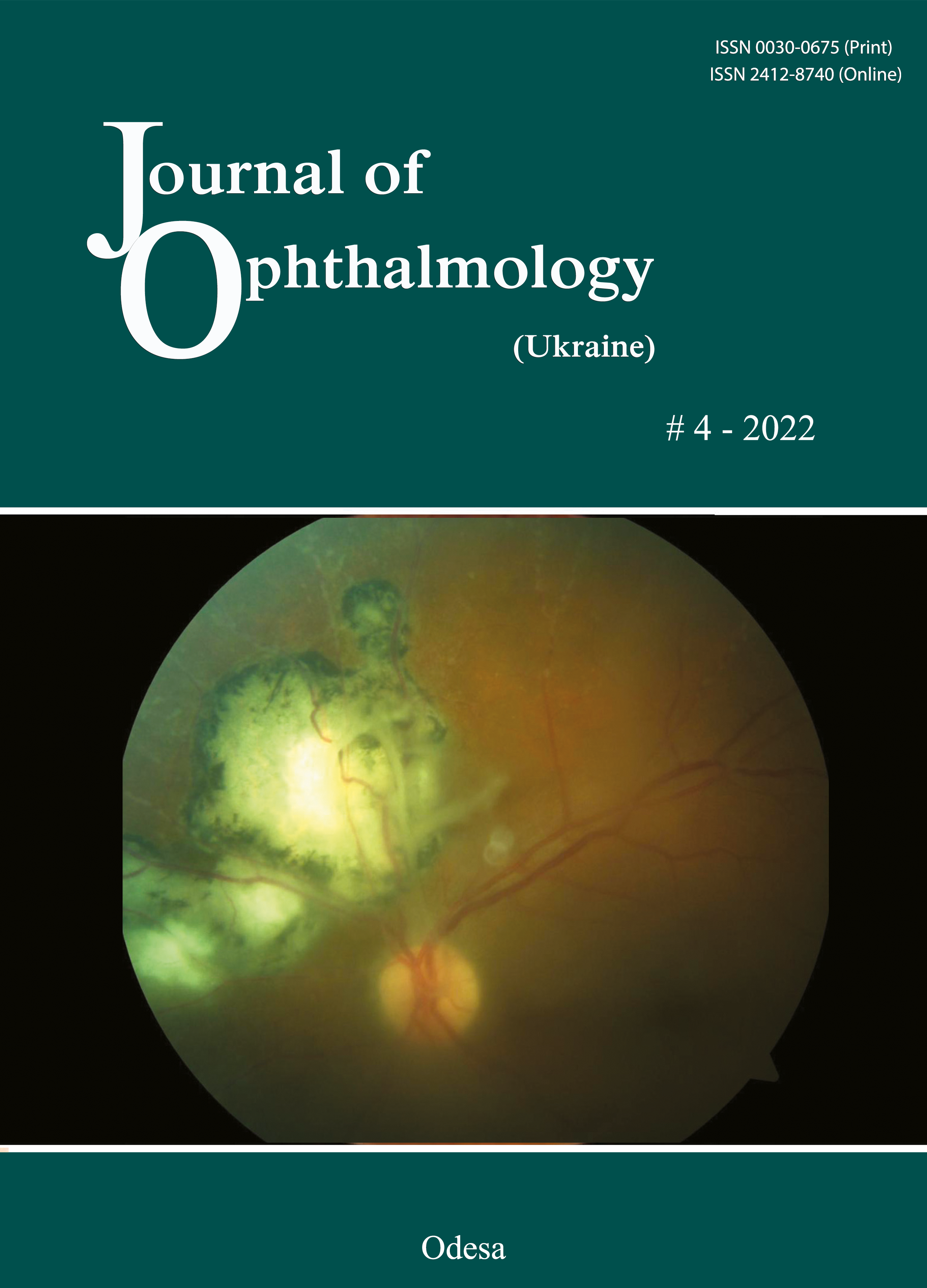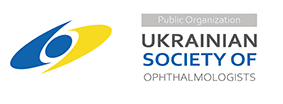Rat tissue responses to dacarbazine-containing implants made of cross-linked polyurethane of different densities
DOI:
https://doi.org/10.31288/oftalmolzh202244048Keywords:
cross-linked polyurethane composite implant, dacarbazine deposition and diffusion, cellular responseAbstract
Background: Restorative orbital and periorbital surgeries require implantable materials containing antimicrobial and anticancer medications.
Purpose: To assess rat tissue responses to dacarbazine-containing implants made of cross-linked polyurethane of different densities.
Material and Methods: Dacarbazine (DC)-containing polyurethane-urea foam (PUUF) implants were a subject of research. We studied the dynamics of DC release from these implant samples. Soft tissue cellular responses to the developed composites were assessed through the implantation of the latter in Wistar rats.
Results: We found that the number of open pores impacts implant survival. There was no substantial difference in DC release between the PUUF samples with a DC weight percent of 1% and those with a DC weight percent of 0.5% at incubation days 1 to 3. At days 5, 7 and 14, an increase in DC release was higher in the former samples than in the latter samples (64% versus 55%). In animals with a subcutaneously implanted PUUF sample, there was histological evidence of (a) formation of a capsule and tight network of blood vessels surrounding an implanted sample at day 3, and (b) separation of the implanted material from the surrounding tissues by a wide cuff of lymphocytes and a thick connective tissue capsule (CTC) at day 7.
Conclusion: The number of open pores impacts DC release and the speed of connective tissue ingrowth into the porous matrix. It was found that a CTC formed around all implants at early time points and at day 30, which in combination with the presence of DC in composite materials resulted in long-term cellular inflammation at the implant placement site.
References
1.Grusha OV, Grusha IaO. [Five hundred orbital plastic repairs: analysis of complications]. Vestn Oftalmol. 2006 Jan-Feb;122(1):22-4. Russian.
2.Gundorova RA, Neroiev VV, Kashnikov VV. [Eye injuries]. Moscow: GEOTAR-Media; 2009. Russian.
3.Denisenko VD, Galatenko NA, Rozhnova RA, Nechaieva LIu. [Medical dacarbazine-containing polyurethane composites based on polyurethane-urea foams. In: Proceedings of the International Conference on Theoretical and Experimental Aspects of Current Chemistry and Materials]. Dnipro, May 20, 2022. p.32-5. Ukrainian.
4.Krasnovid TA. [Ocular trauma under present conditions. Providing urgent care in Ukraine]. Proceedings of the Conference of Ophthalmologists of Chernihiv, Kyiv, Poltava, Sumy and Cherkasy regions of Ukraine. Chernihiv; September 12-13, 2013. pp. 40-4. Russian.
5.Tselomudryi AI, Venger GE, Rizvaniuk AV, Pogorelyi DN. [Surgical rehabilitation of military servicemen with combat eye injuries under current conditions. In: Proceedings of the Filatov Memorial Lectures 2016 Conference]. May 19-20, 2016; Odesa. p.95. Ukrainian.
6.Sevast'ianov VI, Kirpichnikov MP, editors. [Biocompatible materials: a tutorial]. Moscow: Meditsinskoie informatsionnoie agenstvo; 2011. Russian.
7.Uvarova IV, Maksymenko VB. [Bio‐compatible Materials for Medical Products. Educational Manual. Biomedical Engineering Department. National Technical University of Ukraine "KPI")]. Kyiv: KIM, 2013. Ukrainian.
8.Gerasimenko VG, editor. [Biotechnology: a textbook]. Kyiv: INKOS; 2006. Ukrainian.
9.Rudenchyk TV, Rozhnova RA, Galatenko NA, Nechaieva LIu. [Impact of a biological medium model on the structure and characteristics of levamisole-containing composites and drug release patterns]. Voprosy Khimii i Khimicheskoi Tekhnologii. 2018;5:140-8. Ukrainian.
10.Galatenko NA, Rozhnova RA. [Biologically active polymeric materials for medicine]. Kyiv: Naukova Dumka; 2013. Russian.
11.Panarin IeF, Lavrov NA, Solovskii MV, Shalova LI. [Polymers as carriers of biologically active compounds]. Moscow: Professiia; 2014. Russian.
12.Rudenchyk TV, Rozhnova RA, Galatenko NA. [Medical unsaturated ethers and their derivatives]. Polimernyi zhurnal. 2018;40(4):216-29. Ukrainian. https://doi.org/10.15407/polymerj.40.04.216
13.Babker A, Sotnik S, Lyashenko V. Polymeric Materials in Medicine. Sch J Appl Med Sci. 2018;6:148-153. doi: 10.21276/sjams.2018.6.1.33.
14.Kozlova GA, Rozhnova RA, Nechaieva LIu, Galatenko NA. [Impact of a medium model on the structure and characteristics of doxorubicin-containing and with composites based on polyurethane with isocyanurate fragments]. Polimernyi zhurnal. 2021; 43(1):54-63. Ukrainian.
15.Kuliesh DV, Nechaieva LIu, Galatenko NA. [Dynamics of release of methyluracil, a synthetic immunostimulator, from implantable polymer composites]. Dopovidi Natsionalnoi akademii nauk Ukrainy. 2015;3:122-6. Ukrainian.
16.Rudenchyk TV, Rozhnova RA, Galatenko NA, et al. [Developing composites based on oligooxipropylene fumarate, triethylene glycol dimethacrylate and styrole with prolonged levamisole release]. Dopovidi Natsionalnoi akademiyi nauk Ukrayiny. 2016;11:78-86. Ukrainian.
17.Stashenko KV, Rudenchyk TV, Galatenko NA, Rozhnova RA. [Synthesis and properties of composites based on based on polyurethane urea with fragments of a copolymer of polyvinyl butyral (vinyl acetate with vinyl alcohol) with vinyl alcohol and lysozyme]. Pytannia khimii ta khimichnoi tekhnolohii. 2020;1:71-9. Ukrainian.
18.Khodorenko VN, Yasenchuk YuF, Gyunter VE. [Biocompatible materials and implants with shape memory. In: Gyunter VE, editor. Biocompatible porous penetrable materials]. Northampton: STT; Tomsk: STT. p.9-24. Russian.
19.Colnik M, Hrncic MK, Skerget M, Knez Z. Biodegradable polymers, current trends of research and their applications, a review. Chem Ind Chem Eng. Q. 2020;26:401-418. https://doi.org/10.2298/CICEQ191210018C
20.European convention for the protection of vertebrate animals used for experimental and other scientific purposes. Council of Europe, Strasbourg; 1986.
21.Bagrii MM, Dibrova VA, editors. [Methods of morphological research].Vinnytsia: Nova knyha. 2016. Ukrainian.
Downloads
Published
How to Cite
Issue
Section
License
Copyright (c) 2025 Н. А. Галатенко, Р. А. Рожнова, Д. В. Кулєш, В. Д. Денисенко, А. П. Малецький, Н. М. Бігун

This work is licensed under a Creative Commons Attribution 4.0 International License.
This work is licensed under a Creative Commons Attribution 4.0 International (CC BY 4.0) that allows users to read, download, copy, distribute, print, search, or link to the full texts of the articles, or use them for any other lawful purpose, without asking prior permission from the publisher or the author as long as they cite the source.
COPYRIGHT NOTICE
Authors who publish in this journal agree to the following terms:
- Authors hold copyright immediately after publication of their works and retain publishing rights without any restrictions.
- The copyright commencement date complies the publication date of the issue, where the article is included in.
DEPOSIT POLICY
- Authors are permitted and encouraged to post their work online (e.g., in institutional repositories or on their website) during the editorial process, as it can lead to productive exchanges, as well as earlier and greater citation of published work.
- Authors are able to enter into separate, additional contractual arrangements for the non-exclusive distribution of the journal's published version of the work with an acknowledgement of its initial publication in this journal.
- Post-print (post-refereeing manuscript version) and publisher's PDF-version self-archiving is allowed.
- Archiving the pre-print (pre-refereeing manuscript version) not allowed.












